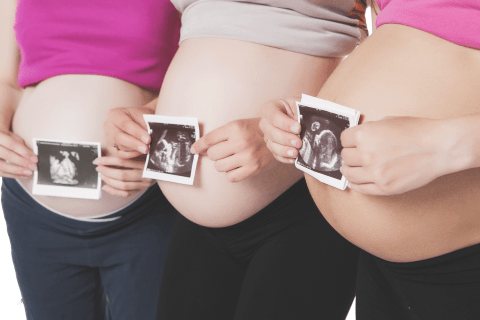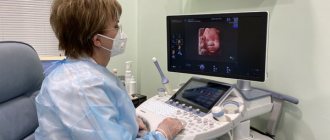The baby has already grown quite well, his weight at week 10 is approximately 4 grams, and his length is about 30-42 mm. When he touches the wall of the uterus, he can already push away from it, but you cannot feel it yet. Basically, all the systems and organs of the little man who is inside you have already been formed, and in the remaining time they will grow and develop.
By the end of the 10th week, the embryonic period of development, considered the most critical, ends and the more “mature” fetal stage begins. This event definitely needs to be celebrated with something delicious! Just don’t forget that alcohol is not recommended for pregnant women! Your baby is now very comfortable in the sac with amniotic fluid, which he swallows. This week there is about 20 ml of liquid in the bladder. All the baby’s organs have already been formed - the brain, liver, intestines, kidneys, stomach, they gradually begin to function and continue to develop. Small nails are already being formed on the tiny fingers and toes, the baby’s skin is covered with a delicate fluff.
At week 10, the baby learned to bend his limbs and his elbow joints formed. In addition, the upper lip and shells of the ears become visible. The spine is clearly visible, and the nerve endings that extend from the spine are also visible. The brain is actively growing, causing the forehead to protrude significantly forward. By the end of this week, the child already looks almost like a real person!
The remainder of the tail hides between the buttocks and becomes the tailbone, the gill slits disappear, and blood vessels form in the lungs. Starting from the 50th day of pregnancy, brain impulses can be recorded, and in science this is the main indicator of human vital activity! Brain impulses are evidence that the baby’s nervous system is already sufficiently developed, all parts of the brain are differentiated, and the cerebral cortex is formed.
Interesting Facts
| Options | Indications |
| Time from conception | 8 weeks |
| Period by month | 10 weeks |
| What month | 3 |
| Dimensions and weight of the fetus | 30-40 mm, 5 g |
| Uterus dimensions | About 10 cm across |
| Pregnant weight | 1-2 kg more than usual |
Your baby is the size of
Cream
30-40mm Size
5 g Weight
In just a couple of months, the baby went from embryo to fetus. All organs and systems are formed and will continue to grow and develop. The symptoms of toxicosis gradually subside in the expectant mother, and spontaneous mood swings go away. What else happens to mother and baby at 10 weeks of pregnancy? Let's look at it in detail, but first let's decide on the calculations.
10 obstetric weeks is how many months? You are 2.5 months pregnant, this is the 1st trimester. If you count the period from conception, then you are at the 8th embryonic week.
Medical examinations
There are no mandatory medical examinations during this period. A doctor may recommend an ultrasound scan only as a routine diagnostic procedure. For example, to track the results of therapy aimed at maintaining pregnancy, or to assess the tone of the uterus, the size of the fetus and ovum at the 10th week of pregnancy. A screening ultrasound will be required a little later - at 11-14 weeks, in addition, during the same period it is recommended to do a biochemical blood screening.
It is extremely important to undergo medical examinations within the time frame recommended by the doctor, since it is during certain periods that you can accurately determine whether the baby is developing correctly, whether he has gross malformations, and whether everything is in order with the uterus and its cervix.
If the doctor has prescribed examinations earlier or the pregnant woman has complaints, it is also necessary to undergo diagnostic procedures. Smear tests to identify pathogenic microflora dangerous to the fetus, blood and urine tests may be required. In the first trimester, it is mandatory to visit specialized specialists: dentist, otolaryngologist, ophthalmologist and therapist, and study an electrocardiogram. Comprehensive monitoring of the health of the expectant mother reduces the risks of complications during pregnancy and helps the woman bear a healthy baby.
pixabay.com/DarkoStojanovic
Feelings of the expectant mother
You may still be bothered by morning sickness. Normally, it disappears completely by week 12, but many notice a decrease in nausea even now. The uterus reached 10-12 cm in size and moved above the pubis. Due to its active growth and the pressure it puts on neighboring organs, you may feel the urge to urinate more often. This is also facilitated by the increased load on the kidneys and the increased volume of circulating blood.
Your belly is still practically invisible, but because of your growing breasts, you probably already need to buy a larger bra.
By the 10th week of pregnancy, sudden mood swings become less pronounced. Drowsiness and constant fatigue disappear, many will notice an increase in performance. Rashes and local inflammation on the face go away, hair becomes noticeably thicker.
External signs of pregnancy
No major external changes have yet occurred, so some women are not even aware of their delicate situation. However, any test can easily determine pregnancy, and if you carefully monitor your own condition, you can identify characteristic signs.
Belly in the tenth week of pregnancy. It is not growing yet and remains flat, so nothing is visible from the outside. But the woman herself may feel some changes: the uterus becomes larger, thickens, which is why a small tubercle appears in the lower abdomen, which is easily palpated. This is especially noticeable in slender women in a lying position: if you lie on your back, you can see a characteristic bulge. In expectant mothers of average and high weight, the presence of a tubercle is not noticeable, but it can already affect clothing: trousers and skirts may not match.
Breasts in the ninth week of pregnancy. Becomes rounder and heavier, making bras tight and uncomfortable. Montgomery's glands become lighter in color.
Swelling. May occur due to fluid stagnation, especially in the lower extremities. In rare cases, swelling indicates the presence of chronic diseases or serious disorders in the body - if such symptoms occur, you should consult a specialist.
Skin pigmentation. If rashes and acne can go away due to hormonal changes, then pigmentation begins to show itself in all its glory. This does not occur in every woman and, as a rule, goes away completely after childbirth. Most often, nipple halos and skin on the chest darken. In some cases, pigmentation spots appear on the face.
Condition of skin and hair. As a rule, a pregnant woman in the tenth week already knows about her situation, so she stops using chemical paints and reduces the amount of cosmetics. This (and hormonal changes) has a beneficial effect on the quality of skin and hair. The epidermis becomes cleaner, comedones and inflammation disappear. Hair acquires a beautiful shine and becomes thicker.
What does a baby look like at 10 weeks of pregnancy?
The size of the fetus at this stage is 30-40 mm, the approximate weight is 5 grams. It is no longer possible to call an unborn child an embryo at 10 weeks. This is a mature fetus, since the formation of all organs and systems has already been completed. A baby at 10 weeks of pregnancy visually resembles a small person. The brain develops, the heart beats, the baby can move his arms and legs. The head is much larger than the body, the vessels are visible through the thin skin.
Fetal development is rapid:
- the placenta has fully formed, which will ensure the production of progesterone instead of the corpus luteum;
- taste buds have appeared, chewing muscles are actively developing;
- the neural tube closes, which will subsequently become the basis of the entire nervous system;
- the liver and kidneys begin to function.
If before the 10th week the skeleton consisted mainly of soft cartilage, now the bone tissue is hardening. For this, the fetus especially needs calcium, which it takes from the mother’s body.
Embryo 2 weeks
On days 8-9 after fertilization, the blastula turns into a gastrula. In this case, the internal cells of the blastula are divided into 3 layers. The outer layer, or ectoderm, will develop into the nervous system and skin. The internal (endoderm) will turn into the cavity of the gastrointestinal tract. The mesoderm, the middle layer, will give rise to the musculoskeletal system (bones, ligaments and cartilage), muscles, kidneys, blood vessels and other internal organs. 10 days after fertilization it is already possible to get a positive pregnancy test result.
Tests and ultrasound
By this time, most expectant mothers have already registered for pregnancy. You need to regularly visit a doctor so that he can assess the condition of the body and identify pathological processes in time. For each visit, you need to take a urine test, which helps to rule out infections and inflammation. Among other important procedures, we note:
- ECG, which allows you to evaluate the work of the heart;
- blood clotting test - to exclude thrombophilia, a condition that threatens pregnancy.
An ultrasound at week 10 is prescribed only according to indications, for example, if there is a suspicion of a threat of interruption.
Preparing for a fetal ultrasound
Preparation depends on the ultrasound method used. You must arrive for a transvaginal examination with an empty bladder. The bladder is emptied immediately before the ultrasound.
In the first trimester, before a transabdominal ultrasound, you need to drink about a liter of water (half an hour to an hour before the procedure). A full bladder facilitates the best propagation of ultrasonic waves. In the second and third trimester, this function is taken over by amniotic fluid, so there is no need to specifically fill the bladder.

In the first trimester, before a transabdominal ultrasound, for 3 days before the procedure, you must follow a diet aimed at emptying the intestines of gases. Coffee, carbonated drinks, raw vegetables and fruits, legumes, sweets and flour, dairy products - all this is recommended to be excluded from the diet. Cabbage should not be consumed even after heat treatment.
What to discuss with your doctor
- Find out when you should have 1 pregnancy screening. If you are being observed at a municipal antenatal clinic, you probably need to sign up for this study in advance in order to be in time before the period of 13 weeks and 6 days, after which it is considered no longer informative.
- If you notice varicose veins on your legs, tell your specialist. In addition to physical exercise and changing posture during long periods of sitting, he may recommend wearing special compression garments and, if necessary, prescribe medication.
- Discuss how you can understand that everything is fine with you and your baby, what symptoms should alert you, and what to do if your health suddenly worsens.
- If you are planning to travel in the second trimester of pregnancy, which is just around the corner, check to see if you have any contraindications to flying.
Embryo 1 week
The zygote is still in the fallopian tube on its way to the uterus. The fallopian tubes are lined with villi, which move the egg towards the uterus. If the zygote does not enter the uterus within a certain time, it may attach to the wall of the fallopian tube. In this case, they talk about ectopic pregnancy - a condition dangerous to health and life.
During fertilization, the sperm brings in its 23 chromosomes, which combine with the 23 chromosomes in the egg. Moreover, depending on whether the sperm contains an X or Y chromosome, the gender of the unborn child depends.
After fertilization and the formation of a zygote, about 30 hours pass. The fertilized egg begins to divide. This process is called fragmentation, since with a slight increase in volume, the number of cells grows exponentially and their size decreases. From 1 you get 2, from 2 you get 4, etc. With an increase in cell mass, the gastrula turns into a morula. The morula looks like a spherical collection of cells. By day 7 after fertilization, the morula turns into a blastula. A fluid-filled cavity, or blastocoel, appears in the center of the embryo. The blastula enters the uterine cavity and is immersed in the mucous layer. This process is called implantation and involves the outer shell of the blastula, called the trophoblast. After implantation, trophoblast cells begin to produce human chorionic gonadotropin, an important hormone that supports pregnancy. Human chorionic gonadotropin can be detected in urine, where its presence is determined using a rapid pregnancy test. By the end of the first week, the size of the embryo is only 0.3 mm.
Complications and ailments at week 10
Compared to previous weeks, the tenth week of pregnancy involves less risk of complications. But still, up to 40% of women encounter various pathologies during this period.
Miscarriage
The risk of spontaneous termination by week 10 is minimal, but unfortunately not excluded. Its signs are brown or red discharge, nagging pain in the lower abdomen. An ultrasound will show a detachment of the membranes and a hematoma. To maintain pregnancy, immediate medical care is required in a hospital setting. Therefore, if you suddenly feel a tug in your stomach or lower back, or vaginal bleeding appears, call an ambulance immediately.
Cervical insufficiency
They talk about it when the cervix becomes shorter and opens prematurely. It is most often asymptomatic and detected during a gynecological examination. Corrected by maintaining sexual rest and wearing a uterine ring.
Preparation required before the procedure
You don’t need to spend too much time preparing for an ultrasound during pregnancy. The procedure itself can hardly be called special; over time, expectant mothers get used to it faster than other tests. The most important thing in the preparation process is to make sure you
calm emotional state, any worries can be passed on to the child and negatively affect the result. The stress hormones produced cause the baby to move excessively and prevent the doctor from getting a good look at the location of the fetus inside the uterine cavity.
Is ultrasound harmful in the early stages? In fact, during a normal pregnancy, ultrasound is recommended to be performed at least 2-3 times during the entire 9 months. If any complications are observed, the schedule may change and the number of visits may become more frequent. Accordingly, there is no harm from the procedure, since doctors so boldly prescribe it more often than others.
You can learn more about how ultrasound is performed in the early stages at a consultation with our specialist. The doctors at the Istok Health Clinic guarantee all their patients attentive treatment and professional service. Call!
Do's and Don'ts
Starting from the 10th week, the placenta begins to protect the baby from negative environmental factors. However, this does not mean that a woman can forget about her situation. She is still prohibited from drinking alcohol or smoking, lifting more than 3 kg, taking a hot bath or taking any medications unless prescribed by a doctor. All this can disrupt the development of the fetus and lead to termination of pregnancy.
But what is possible?
- Do work or study, taking breaks every hour to change position if the work is sedentary.
- Lead a normal lifestyle, see friends, travel, etc., because pregnancy is not a disease and positive emotions will only benefit you.
- In the absence of contraindications, such as the threat of interruption or cervical insufficiency, physical intimacy is possible. Sex also brings joy, and after week 10, many women note an increase in libido.
- Find space in your schedule for physical activity. Walking, swimming, yoga - sports strengthens muscles, develops the respiratory system, making the process of pregnancy and childbirth easier and more enjoyable.
What types of ultrasound are prescribed during pregnancy?
Ultrasound in early pregnancy can be performed in two ways:
Ultrasound through the abdominal wall (abdominal) in early pregnancy
With its help, it is possible to assess the quality of fetal development in the womb. Moreover, the lower part of the abdomen is scanned, actually near the location of the uterus. A special gel is applied to the skin, which improves the passage of ultrasound. The sensor of the measuring apparatus sends ultrasound waves, they are reflected from the organs and contents of the uterine cavity, and then transmit the image to the monitor screen. Thanks to this, it is possible to thoroughly examine the child, determine its gender and check the development of the fetus.
Transvaginal ultrasound in early pregnancy
A vaginal sensor is used here, which allows you to examine the condition of the developing child from the inside and identify the presence of pathologies or developmental features at the earliest stages. A prerequisite for preparing for a transvaginal ultrasound is to completely empty the bladder.
After the procedure is completed, the pregnant woman receives the first official document for this case, which describes not only the timing of the conception of the embryo, but also a description of the size of the fetus, viability, and normal development of internal organs.
Checklist for 10 weeks of pregnancy
- Think about how you will spend the second trimester. If possible, go on vacation. This is a great time: the discomfort of the first trimester will subside, your previous energy will return, and the size of your belly will still allow you to move with ease. Take advantage of this moment!
- Buy containers for liquid tests, because you will need to take a general urine test at least twice a month.
- Add calcium-rich foods to your daily diet: cheese, cottage cheese, sesame seeds, almonds, garlic, parsley.
- Sign up for 1 pregnancy screening. It must be done before 13 weeks and 6 days.
Let us remind you that you can undergo all tests during pregnancy, including prenatal screening, at the Women's Medical Center at any time convenient for you. We guarantee no waiting and 100% accurate results.
How pregnancy begins and develops
Fertilization
Every time in the middle of the menstrual cycle, one, rarely several, follicle matures in the ovaries. The follicle contains an egg. The moment the egg is released from the follicle is called ovulation. After release, the egg is picked up by the fallopian tubes and slowly moves towards the uterine cavity. If during this short (3-6 days) period of time a woman has sexual intercourse without means of preventing pregnancy, pregnancy may occur. The egg produces special substances that signal the sperm about where it is. If the “rendezvous” takes place, fertilization occurs. Pregnancy begins.
Fertilization occurs in the fallopian tubes, even before the egg enters the uterine cavity. After the fusion of the egg and sperm, a zygote is formed, from which the growth of the embryo begins.
What happens and what does the embryo look like? How will the size of the embryo change over the weeks? What changes will occur during the process of growth and development? What do photos of an embryo look like by week? Ultrasound is used to observe how the embryo develops over weeks and months.







